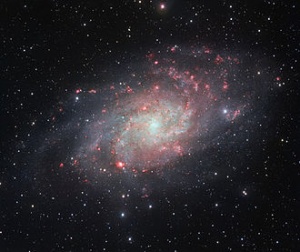Messier 33: Difference between revisions
No edit summary |
|||
| Line 7: | Line 7: | ||
==Moving towards Andromeda== | ==Moving towards Andromeda== | ||
In 2006, a group of astronomers announced the discovery of an eclipsing binary star in the Triangulum Galaxy. By studying the eclipses of the stars, astronomers were able to measure their sizes.he Triangulum galaxy is a source of H2O maser emission.In 2005, using observations of two water masers on opposite sides of Triangulum via the VLBA, researchers were, for the first time, able to estimate the angular rotation and proper motion of Triangulum. A velocity of 190 ± 60 km/s relative to the Milky Way was computed, which means Triangulum is moving towards Andromeda and suggesting it may be a satellite of the larger galaxy (depending on their relative distances and margins of error). In 2004, evidence was announced of a clumpy stream of hydrogen gas linking the Andromeda Galaxy with Triangulum, suggesting that the two may have tidally interacted in the past. This discovery was confirmed in 2011. | In 2006, a group of astronomers announced the discovery of an eclipsing binary star in the Triangulum Galaxy. By studying the eclipses of the stars, astronomers were able to measure their sizes.he Triangulum galaxy is a source of H2O maser emission.In 2005, using observations of two water masers on opposite sides of Triangulum via the VLBA, researchers were, for the first time, able to estimate the angular rotation and proper motion of Triangulum. A velocity of 190 ± 60 km/s relative to the Milky Way was computed, which means Triangulum is moving towards Andromeda and suggesting it may be a satellite of the larger galaxy (depending on their relative distances and margins of error). In 2004, evidence was announced of a clumpy stream of hydrogen gas linking the Andromeda Galaxy with Triangulum, suggesting that the two may have tidally interacted in the past. This discovery was confirmed in 2011.<ref>[http://en.wikipedia.org/wiki/Triangulum_Galaxy Triangulum Galaxy]</ref> | ||
==Session References== | ==Session References== | ||
Revision as of 23:39, 13 March 2015
The Triangulum Galaxy is a spiral galaxy approximately 3 million light-years (ly) from Earth in the constellation Triangulum. It is catalogued as Messier 33 or NGC 598, and is sometimes informally referred to as the Pinwheel Galaxy, a nickname it shares with Messier 101. The Triangulum Galaxy is the third-largest member of the Local Group of galaxies, which includes the Milky Way, the Andromeda Galaxy and about 44 other smaller galaxies. It is one of the most distant permanent objects that can be viewed with the naked eye. The galaxy is the smallest spiral galaxy in the Local Group and it is believed to be a satellite of the Andromeda Galaxy due to their interactions, velocities and proximity of one another in the night sky.With a diameter of about 60,000 light-years, the Triangulum galaxy is the third largest member of the Local Group of galaxies. It may be a gravitationally bound companion of the Andromeda Galaxy. Triangulum may be home to 40 billion stars, compared to 400 billion for the Milky Way, and 1 trillion stars for Andromeda. [1]
Moving towards Andromeda
In 2006, a group of astronomers announced the discovery of an eclipsing binary star in the Triangulum Galaxy. By studying the eclipses of the stars, astronomers were able to measure their sizes.he Triangulum galaxy is a source of H2O maser emission.In 2005, using observations of two water masers on opposite sides of Triangulum via the VLBA, researchers were, for the first time, able to estimate the angular rotation and proper motion of Triangulum. A velocity of 190 ± 60 km/s relative to the Milky Way was computed, which means Triangulum is moving towards Andromeda and suggesting it may be a satellite of the larger galaxy (depending on their relative distances and margins of error). In 2004, evidence was announced of a clumpy stream of hydrogen gas linking the Andromeda Galaxy with Triangulum, suggesting that the two may have tidally interacted in the past. This discovery was confirmed in 2011.[2]
Session References
- HGS Sessions - Clearing Dragon Moth Grid and Blue Oxen Network - 3/5/2015 [3]
References
Found in HGS Manual on Page 108


